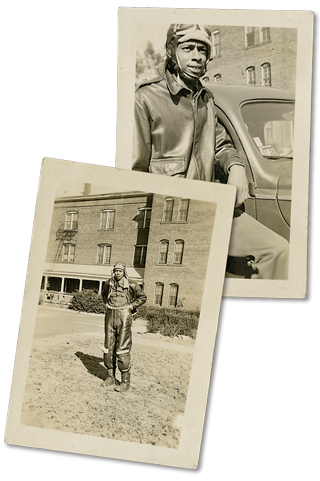In his short life, Richmond native Clemenceau “Clem” McAdoo Givings found a vocation he was seemingly born for and helped reshape the U.S. Armed Forces.
When World War II broke out in 1939, the military – like most of American society – was deeply segregated. Black service members were separated from white soldiers, usually limited to menial roles, and often served under white officers. They were expected to fight for a nation that didn’t grant them equal rights.
 Such injustices spurred Civil Rights organizations to lobby for change. Yielding to this pressure, the U.S. Army Air Corps (predecessor of the Air Force) established a program in Tuskegee, Alabama, to train Black aviators. Between 1941 and 1946, nearly a thousand pilots graduated and more than 14,600 men and women were trained as navigators, bombardiers, mechanics, and other service personnel.
Such injustices spurred Civil Rights organizations to lobby for change. Yielding to this pressure, the U.S. Army Air Corps (predecessor of the Air Force) established a program in Tuskegee, Alabama, to train Black aviators. Between 1941 and 1946, nearly a thousand pilots graduated and more than 14,600 men and women were trained as navigators, bombardiers, mechanics, and other service personnel.
Clem Givings was born in Richmond on November 4, 1919. He graduated from Armstrong High School in June 1936 and enrolled at Virginia Union University after being awarded a Richmond News Leader scholarship. In 1941, Givings enlisted in the military, and the following year he entered the Tuskegee Army Flying School in Alabama.
Fascinated with flying since childhood, he wrote to his parents of his passion:
I just can’t begin to describe the beauty of the sky and sea. It’s just another of those things that stresses the magnificence of God and the smallness of mankind in the universe.
In 1943, Givings became one of the first Richmonders to earn his wings, and he did so as a Tuskegee Airman. He was a natural fit for the job. A fellow officer described Givings as “strictly air corps, incorporating in his decorum all the zest, cocksureness, pride, and braggadocio that is the essence of a fighter pilot’s makeup.”
As part of the 100th Fighter Squadron, Givings was stationed in Italy in January 1944 where he saw action in the months-long Allied offensive against German forces. On March 18, 1944, engine failure caused his plane to crash during a coastal patrol. The squadron of Tuskegee Airmen lost its first pilot in combat when he died. He was twenty-four years old. Givings was one of the eighty-four Tuskegee Airmen to make the ultimate sacrifice during World War II.
In total, Tuskegee Airmen flew more than 15,000 sorties and completed more than 1,500 missions between May 1943 and June 1945. They sank an enemy destroyer and destroyed 409 enemy aircraft, along with rail traffic, coastal watching stations, and hundreds of vehicles. The success and heroism of the Tuskegee Airmen dispelled racist doubts and misconceptions about the abilities and potential of Black service members and helped influence President Harry S. Truman’s 1948 executive order to desegregate the armed services.
Lt. Givings was posthumously awarded a Purple Heart in recognition of his service. Givings’ mother Ruth compiled a scrapbook containing memorabilia from her son’s school days, documents related to his military career, and letters he sent to the family’s home on East Leigh Street in Richmond. It is now part of the collection at VMHC.

Photography: Courtesy Virginia Museum of History & Culture







